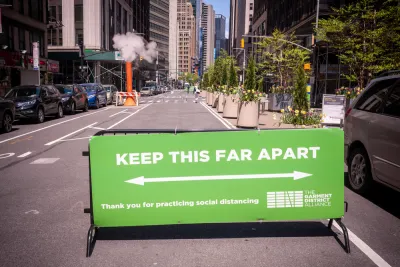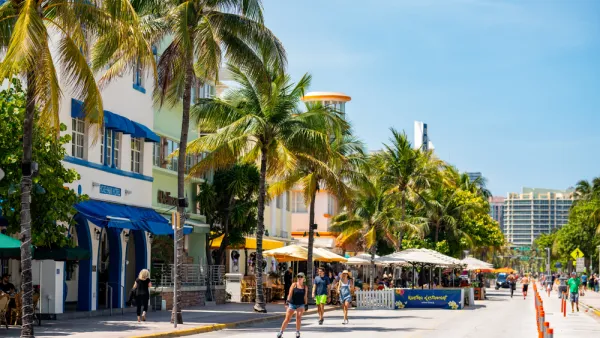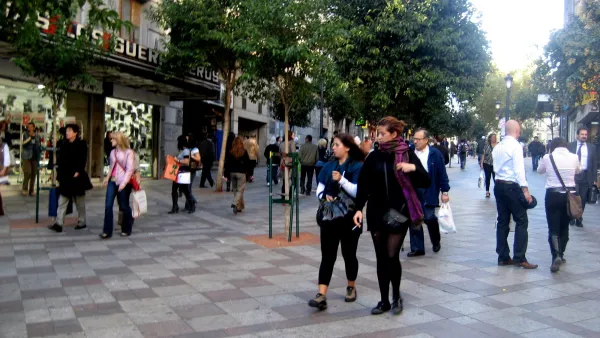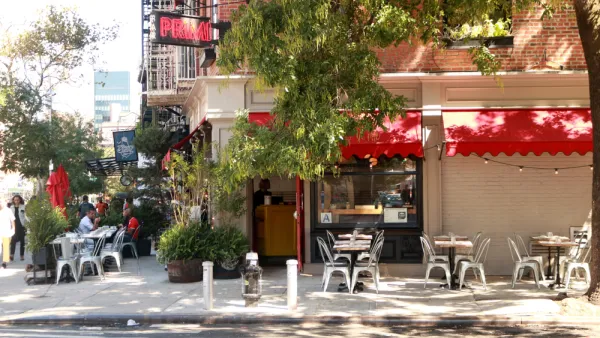With more people getting back in their cars, can pedestrian-oriented open streets survive?

When the pandemic forced restaurants to find creative ways to serve customers and people found themselves having to stay safe and sane in their own small neighborhoods, the concept of "open streets" caught on around the country as communities sought new ways to reclaim street space from cars and provide more safe outdoor space for residents. However, with COVID-19 restrictions starting to lift, writes Danielle Mudio for Politico, many formerly "open" streets have reverted to their original use.
At the height of pandemic planning, after initial reluctance from Mayor De Blasio, New York City pledged to pedestrianize 100 miles of roadway. Community groups took matters into their own hands, too: in Jackson Heights, volunteers raised $20,000 to create a 26-block open streets zone on 34th Avenue. But of the 83 miles of roadway that were eventually opened for pedestrian use during the pandemic, 22 have since shut down; "half were closed permanently while the rest shuttered temporarily for the winter, said Mitch Schwartz, a spokesperson for the de Blasio administration."
While most open streets programs were managed by volunteers, advocates say that "a redesign of city streets to include more permanent barriers, new signs and extra seating is necessary to keep cars off the roads and ensure they can be safely used by all." Because the programs often require "heroic or unusual effort by the community," writes Mudio, not all neighborhoods have the resources to maintain open streets programs without assistance from the city. Now, a coalition of "roughly 60 transportation and neighborhood groups" is calling for the city to "dedicate resources to support volunteers, provide amenities like improved barriers and provide daily programming activities." For their part, the city claims they are "considering a model that would provide reimbursement funding and technical assistance to community partners who lack resources" to implement and maintain open streets.
FULL STORY: Open Streets closed: Cars are reclaiming city blocks set aside for recreation

National Parks Layoffs Will Cause Communities to Lose Billions
Thousands of essential park workers were laid off this week, just before the busy spring break season.

Retro-silient?: America’s First “Eco-burb,” The Woodlands Turns 50
A master-planned community north of Houston offers lessons on green infrastructure and resilient design, but falls short of its founder’s lofty affordability and walkability goals.

Delivering for America Plan Will Downgrade Mail Service in at Least 49.5 Percent of Zip Codes
Republican and Democrat lawmakers criticize the plan for its disproportionate negative impact on rural communities.

Test News Post 1
This is a summary

Test News Headline 46
Test for the image on the front page.

Balancing Bombs and Butterflies: How the National Guard Protects a Rare Species
The National Guard at Fort Indiantown Gap uses GIS technology and land management strategies to balance military training with conservation efforts, ensuring the survival of the rare eastern regal fritillary butterfly.
Urban Design for Planners 1: Software Tools
This six-course series explores essential urban design concepts using open source software and equips planners with the tools they need to participate fully in the urban design process.
Planning for Universal Design
Learn the tools for implementing Universal Design in planning regulations.
EMC Planning Group, Inc.
Planetizen
Planetizen
Mpact (formerly Rail~Volution)
Great Falls Development Authority, Inc.
HUDs Office of Policy Development and Research
NYU Wagner Graduate School of Public Service





























